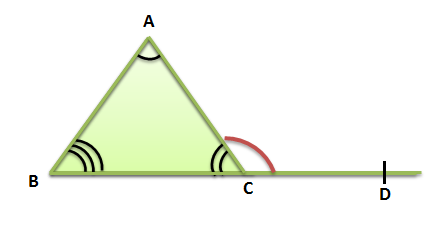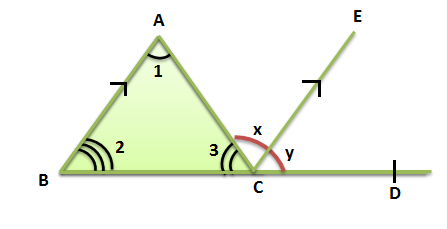Triangles, Exterior Angle Theorem
Exterior Angle Theorem
The exterior angle theorem states that if a triangle’s side gets an extension, then the resultant exterior angle would be equal to the total of the two opposite interior angles of the triangle.

Fig. 2 Exterior Angle Theorem
According to the Exterior Angle Theorem the sum of measures of ∠ABC and ∠CAB would be equal to the exterior angle ∠ACD . General proof of this theorem is explained below:
Proof:
Consider a ∆ABC as shown in fig. 2, such that side BC of ∆ABC is extended. A line, parallel to the side AB is drawn as shown in the figure.

Fig. 3 Exterior Angle Theorem
| S. No | Statement | Reason |
| 1. | ∠CAB = ∠ACE ⇒∠1=∠x | Pair of alternate angles(( |
| 2. | ∠ABC = ∠ECD ⇒∠2 = ∠y | Corresponding angles (( |
| 3. | ⇒∠1+∠2 = ∠x+∠y | From statements 1 and 2 |
| 4. | ∠x+∠y = ∠ACD | From fig. 3 |
| 5. | ∠1+∠2 = ∠ACD | From statements 3 and 4 |
Thus, from above statements it can be seen that exterior ∠ACD of ∆ABC is equal to the sum of two opposite interior angles i.e. ∠CAB and ∠ABC of the ∆ABC.
Comments
Post a Comment
Thank You For Visit To My Blog ...
you will soon get the reply.. for your comment.......